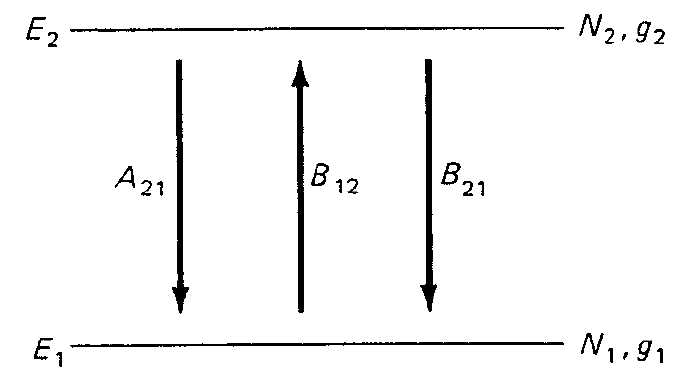
Boltzmann’s Statistics
 المؤلف:
Walter Koechner Michael Bass
المؤلف:
Walter Koechner Michael Bass
 المصدر:
Solid-state Lasers
المصدر:
Solid-state Lasers
 الجزء والصفحة:
16
الجزء والصفحة:
16
 26-1-2021
26-1-2021
 1645
1645
Boltzmann’s Statistics
According to a basic principle of statistical mechanics, when a large collection of similar atoms is in thermal equilibrium at temperature T, the relative populations of any two energy levels E1 and E2, such as the ones shown in Fig. 1.1, must be related by the Boltzmann ratio
 ..........(1)
..........(1)

FIGURE 1.1. Two energy levels with population N1, N2 and degeneracies g1, g2, respectively.
where N1 and N2 are the number of atoms in the energy levels E1 and E2, respectively. For energy gaps large enough that E2 − E1 = hν21 � kT , the ratio is close to zero, and there will be very few atoms in the upper energy level at thermal equilibrium. The thermal energy kT at room temperature (T ≈ 300 K) corresponds to an energy gap hν with ν ≈ 6 × 1012 Hz, which is equivalent in wavelength to λ ≈ 50μm. Therefore, for any energy gap whose transition frequency ν21 lies in the near-infrared or visible regions, the Boltzmann exponent will be very small at normal temperatures. The number of atoms in any upper level will then be very small compared to the lower levels. For example, in ruby the ground level E1 and the upper laser level E2 are separated by an energy gap corresponding to a wavelength of λ ≈ 0.69μm. Since h = 6.6 × 10−34 Ws2, then E2 − E1 = hν = 2.86 × 10−19Ws. With k = 1.38 × 10−23 Ws K and T = 300 K, it follows that N2/N1 ≈ exp(−69). Therefore at thermal equilibrium virtually all the ions will be in the ground level.
Equation (1) is valid for atomic systems having only nondegenerate levels. If there are gi different states of the atom corresponding to the energy Ei , then gi is defined as the degeneracy of the i th energy level.
We recall that atomic systems, such as atoms, ions, and molecules, can exist only in certain stationary states, each of which corresponds to a definite value of energy and thus specifies an energy level. When two or more states have the same energy, the respective level is called degenerate, and the number of states with the same energy is the multiplicity of the level. All states of the same energy level will be equally populated, therefore the number of atoms in levels 1 and 2 is N1 = g1N'1 and N2 = g2N'2, where N'1 and N' 2 refer to the population of any of the states in levels 1 and 2, respectively. It follows then from (1) that the populations of the energy levels 1 and 2 are related by the formula
 ............(2)
............(2)
At absolute zero temperature, Boltzmann’s statistics predict that all atoms will be in the ground state. Thermal equilibrium at any temperature requires that a state with a lower energy be more densely populated than a state with a higher energy. Therefore N2/N1 is always less than unity for E2 > E1 and T > 0. This means that optical amplification is not possible in thermal equilibrium.
 الاكثر قراءة في مواضيع عامة في الليزر
الاكثر قراءة في مواضيع عامة في الليزر
 اخر الاخبار
اخر الاخبار
اخبار العتبة العباسية المقدسة


